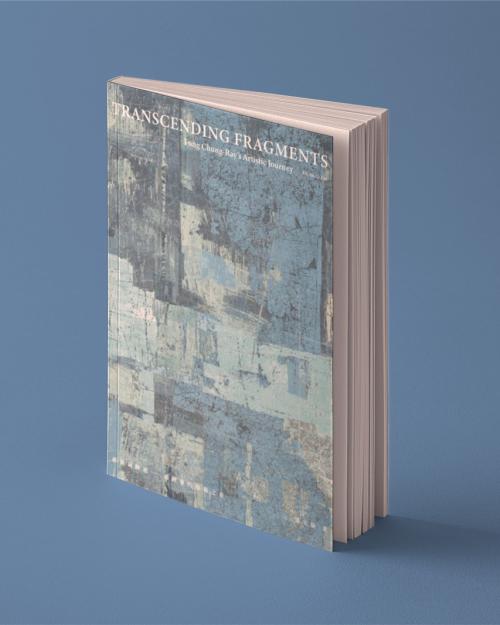While there may not be a direct connection between an artist’s early life and his art, it is important to start the story of Fong Chung-Ray, a pioneer of modern art in Taiwan, with his war-torn youth, said art historian An-Yi Pan.
Born in China’s Henan Province in 1934, Fong grew up in a family that valued education, even as the Sino-Japanese War and then the Chinese Civil War forced them to move again and again. In “Transcending Fragments: Fong Chung-Ray’s Artistic Journey,” Pan tells how, at 14, Fong left his family to hike more than 600 kilometers with his school class, following the Kuomintang government retreat to Taiwan. There, Fong joined the military, which opened opportunities for him to train as a painter.
“Fong credited his venturing into art to his tumultuous early life,” said Pan, associate professor of history of art and visual studies in the College of Arts and Sciences. “He noted that had it not been for the constant war, he probably would have pursued a typical, normal career. It was the wars that brought him and his friends together. Many of them became major artists and poets in postwar Taiwan.”
Presented in both Chinese and English languages in one volume, “Transcending Fragments” is the first detailed account of Fong’s life and art. Pan’s research included extensive interviews with the artist, who still paints every day in his San Francisco studio.
The College of Arts and Sciences spoke with Pan about the book.
Question: What inspired you to write this study of Fong Chung-Ray?
Answer: I have been working on postwar Taiwanese modernism, and Fong being a key figure of this movement is naturally a topic that I am exploring. My new book on postwar Taiwan modernism draws from artistic movements from 1945 to the mid-1960s, years during which Fong was a major player among artistic endeavors on the island.
Fong was one of the pioneers of modern art in Taiwan in the 1950s. He first exhibited with three of his naval officer colleagues from southern Taiwan in Taipei, the capital, in 1958. The group was later named the Four Seas Painting Group. Fong joined the Fifth Moon Painting Group in 1961, one of the two most prominent modern art groups in Taiwan at the time.
After he moved to the San Francisco Bay Area in the early 1970s, he was “forgotten” by the art world in Taiwan. Yet Fong, a very quiet person, has steadily advanced his art. I was fascinated by his art when I finally located him in the late 2010s. Though a few other art historians wanted to work on him, he and I felt a strong affinity toward each other. In the end it was a mutual decision and we agreed that I was best suited to work on the story of his life and art.
Q: The forward by Dr. Shen Kui-yi says that you correct several misinterpretations of Fong Chung-Ray’s work. How has his work been misunderstood in the past?
A: I think the misinterpretations are beyond just Fong himself. First, prior to my study, no one really understood the Four Seas Painting Group. My work thus clears up many misperceptions about the group. Second, Taiwan’s participation in the São Paulo Biennale had also been misinterpreted through a biased viewpoint. My work takes all the communications at the time into consideration and questions the validity of relying solely on postcolonial discourse.
Fong became a Buddhist in the 1980s, and his art was strongly informed by his sincere faith. No scholars have yet examined his art through his faith. My work helps readers explore this unknown facet of Fong’s life and art.
Q: What would you most like readers to learn about Fong Chung-Ray’s painting, especially those meeting him and his art for the first time?
A: I’d like readers to contextualize Fong’s art within Taiwan’s postwar modernism. It was a time when postwar global modernism was most inspired by the New York school: abstract expressionism. In Taiwan, modern painters sought to join this global movement with their strong Chinese artistic traditions.
While the New York school artists were influenced by Japanese Zen art and calligraphy, many of them denied this connection. Chinese artists in Taiwan understood that Zen was derived from the Chinese Chan Buddhist tradition, and Japanese calligraphy was derived from Chinese calligraphy, so they could legitimately claim this cultural heritage on a global stage. They delved into ancient Chinese philosophy and art history to articulate theories behind their aesthetics. Fong was a major player in this movement, and his early art should be understood in this context.
In essence, Fong’s art and life are a microcosm of a forgotten and underappreciated period of Chinese art. Fong’s six decades of art creation not only encapsulate his personal experience but also represent an era of Chinese modernism. Given that art production on the Mainland was entirely closed off from the outside world in political service to socialist ideologies, those who could represent modernist Chinese art and its movement on the postwar global stage were Fong and his fellow Chinese artists in Taiwan. Their coming of age and the effects of war had forced them to migrate to the island where they flourished in a much-desired creative environment, though not in an entirely democratic society.





